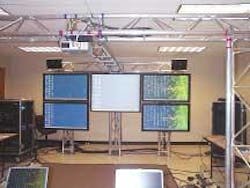Army Tactical Operations Centers in Iraq use RGB Spectrum's display technology
ALAMEDA, Calif. — Officials at audio-visual system specialists MCSi in Raleigh, N.C., used the QuadView display processors from RGB Spectrum in Alameda, Calif., for mobile tactical operations centers (TOCs) used by the U.S. Army's 82nd Airborne Infantry Division.
"MCSi was charged with developing a new mobile command post that would perform flawlessly under extreme conditions with optimum image quality," says Betsy Mayer, senior account executive for MCSi and civilian manager for the project. "This new TOC had to meet portability requirements of the infantry command and integrate numerous live battlefield images into a centralized observation and command center."
"Previous command centers tracked the battlefield theater in an outdated manner. Personnel used 6-foot by 6-foot maps and stuck pins with labels in them. They also used old computer systems to track data, which had to be printed and placed on the map because the information could not be fed into any type of display device. Our mission was to evolve this primitive system to a far more efficient and effective battlefield communication center."
"To maximize situation awareness for the command personnel, we needed a display system that could show multiple images from a variety of inputs on one screen. Additionally, the equipment had to withstand the harsh conditions out in the desert. This was a custom design, which came down to quality and reliability. MCSi's experience with RGB Spectrum's QuadView display processor made the choice simple. The QuadView offers field- proven dependability, supports the myriad of battlefield input signals required, and displays four images simultaneously in real time on a single display with excellent quality."
The QuadView processors receive computer and video inputs. Computer inputs come from a group of 12 PCs with images consisting of maps, force tracking, and resources databases, satellite down-linked broadcasts and surveillance, intelligence reports, weapons control, enemy target acquisition, Internet pages, and PowerPoint briefings, RGB Spectrum officials say. Video sources include DVD players, VCRs, and surveillance video cameras. User-selectable output settings go as high as a 1600-by-1200 resolution in both RGB and DVI format. With DVI inputs and outputs, a completely digital signal path is provided from source to display for optimal image quality, company officials say. For added convenience, dual outputs in RGB and DVI allow feeding two separate displays. The QuadView XLRT automatically determines the output display's characteristics and optimizes its output signal for that device.
The QuadView processors feed these combined images to truss-mounted Panasonic TH-50HD5U 50-inch plasma screens in their native 16:9 aspect ratio and 1366-by-768 resolution. Army personnel operate the TOC display systems with an AMX AXT-CA10 touch-panel control system. Operators can control the QuadViews' display capabilities at the push of a button to select input sources, size, and position images anywhere on screen, pan, and zoom images, and overlap images. The QuadView processors support 16:9 and 4:3 aspect ratios, which enable operators to switch the QuadView output to any display device within the TOC, which, in addition to the plasma screens, include two Hitachi CP-X380 LCD projectors, two Zenith L15V26 15-inch flat panel displays, and a 27-inch color monitor. The new mobile command center is housed in a C-130 aircraft transport container and can be set up and dismantled in less than an hour. It is deployed in a J-series "drash" tent measuring 80 by 30 feet.
"The key design factor was that we had to supply the most reliable equipment," Mayer says. "The QuadView processors took the blow of sandstorms and 100-plus degree heat and performed impeccably. The Army is very pleased with QuadView's image quality, displaying sharp, clear visuals. The Army is working to establish this new TOC as the standard and is in the process of purchasing more mobile infantry command centers."
The QuadView Plus processor combines as many as four computer and/or video signals on a single monitor or projector. Each input channel offers a choice of NTSC or PAL composite, component, S-Video, and high-resolution analog RGB as high as 1600-by-1200-pixel resolution. Unlimited display options include simultaneous viewing of four inputs in quadrants, side-by-side display, and picture-in-picture, full screen display of any single input, overlapping display windows, and 16:9 aspect ratio support. Each input can be scaled and positioned anywhere on the screen, as well as panned, zoomed, and overplayed, RGB Spectrum officials say. Inputs can be from virtually any source, including cameras, tape recorders, teleconferencing systems, desktop computers, videodiscs, etc.
For more information on MCSi go online at www.mcsinet.com. For more information on RGB Spectrum go to www.rgb.com.

